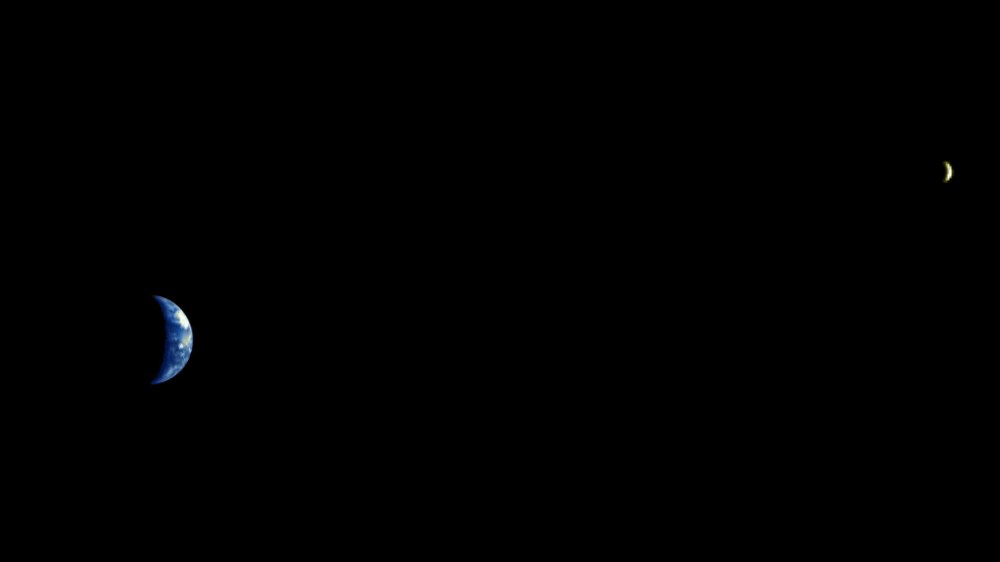Earth and Moon seen from Mars

ESA/DLR/FU Berlin, CC BY-SA 3.0 IGO
- The DLR High Resolution Stereo Camera on board ESA's Mars Express spacecraft has imaged Earth and Moon from a distance of approximately 300 million kilometres.
- The image parallels one acquired with HRSC 20 years ago, just one month after the launch of Mars Express.
- The image is reminiscent of the famous 'Pale Blue Dot' photo and the book of the same name written by astronomer Carl Sagan.
- Focus: Earth, Moon, Mars, Solar System exploration
The image featured in this article is certainly not the most impressive shot of the Earth and Moon from space. The 'simple image' acquired by the High Resolution Stereo Camera (HRSC) of the German Aerospace Center (Deutsches Zentrum für Luft- und Raumfahrt; DLR) on board the European Space Agency (ESA) Mars Express spacecraft nevertheless evokes the poignant feeling of a distant view of the 'Pale Blue Dot', Earth.
Earth was first described as a pale blue dot by scientist and communicator Carl Sagan, inspired by a humbling 1990 image captured by NASA's Voyager 1 as it looked back towards Earth from beyond the orbit of Neptune, some six billion kilometres away. The Voyager data acquired from this vantage point was used to create a mosaic of the Solar System including views of the eight planets Mercury, Venus, Earth, Mars, Jupiter, Saturn, Uranus and Neptune captured across several images. The mosaic inspired Sagan's legendary 1994 book 'Pale Blue Dot: A Vision of the Human Future in Space', in which he described Earth as the only world known so far to harbour life and underscored our responsibility to deal more kindly with one another, and to take care to preserve our home planet.
More than three decades have passed since that iconic image was taken, during which time numerous space probes have similarly turned to image Earth as they voyage on to their destinations far and wide in the Solar System. Rovers and orbiters around Mars have also sent their share of snapshots while exploring Mars. Yet Sagan's message of the 1990s remains more urgent than ever.
"On the special occasion of Mars Express's 20th anniversary since launch, we wanted to bring Carl Sagan's reflections back to the present day, in which the worsening climate and ecological crisis make them more valid than ever," says Jorge Hernández Bernal of the University of the Basque Country and Sorbonne University, and part of the Mars Express team who initiated this image.
"In these simple snapshots from Mars Express, Earth has the equivalent size as an ant seen from a distance of 100 metres, and we are all in there. Even though we have seen images like these before, it is still humbling to pause and think: we need to look after the pale blue dot, there is no planet B."

ESA/DLR/FU Berlin, CC BY-SA 3.0 IGO
The sequence of images was acquired by the super resolution channel (SRC) of Mars Express' High Resolution Stereo Camera (HRSC). The SRC is a telephoto lens with a black-and-white sensor, which is primarily used for observing Mars's two moons and the stars. The images show Earth and its moon on 15, 21 and 27 May, and 2 June 2023. This covers more than half of the Moon's monthly orbit around the Earth.
The final image in the sequence marked the anniversary of the launch of Mars Express on 2 June 2003. It was taken shortly before a special anniversary event during which images of Mars taken by the spacecraft's Visual Monitoring Camera (VMC) were beamed 'live' back to Earth with a delay of only approximately 16 minutes in a first-of-its-kind broadcast.
"There is no scientific value in these images, but since the conditions allowed us to point the HRSC to Earth and shortly after the VMC to Mars, we took the opportunity to create our own portrait of home on this incredible mission milestone for Mars Express," says Daniela Tirsch, member of the Mars Express HRSC team at the German Aerospace Center, (Deutsches Zentrum für Luft- und Raumfahrt; DLR).
The very first planetary image taken by the mission 20 years ago was of the Earth-Moon system. On the night of 3 July 2003, the spacecraft was pointed backwards to obtain a breathtaking view of our planet and moon from a distance of just eight million kilometres while on its way to Mars. By comparison, the 2023 images were taken from around 300 million kilometres.
"Perhaps it will only be another 20 years before humans can look up from the surface of Mars to see Earth in the night sky," adds Colin Wilson, ESA project scientist for Mars Express and the ExoMars Trace Gas Orbiter. "ESA has a long history of Mars exploration, first from orbit with Mars Express and the Trace Gas Orbiter, and in the next decade also on the surface with the Rosalind Franklin rover and the completion of the Mars Sample Return missions. The next bold ambition is of course to explore with humans."
Related links
The HRSC experiment on Mars Express
The High Resolution Stereo Camera (HRSC) was developed at the German Aerospace Center (DLR) and built in cooperation with industrial partners (EADS Astrium, Lewicki Microelectronic GmbH and Jena-Optronik GmbH). The science team, led by Principal Investigator (PI) Dr Thomas Roatsch of the DLR Institute of Planetary Research, consists of 52 co-investigators from 34 institutions and 11 nations. The camera is operated by the DLR Institute of Planetary Research in Berlin-Adlershof.
These high-resolution images and more images acquired by HRSC can be found in the Mars Express image gallery on flickr.
